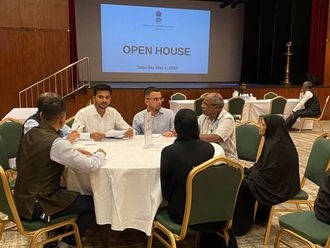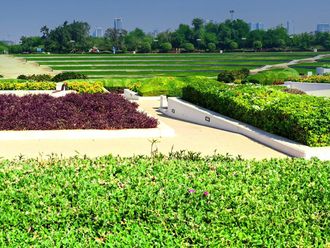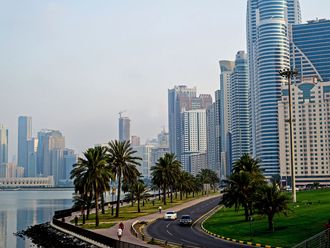With a few bold strokes, a cartoonist expresses more than words can say. The best cartoonists in the world are adept at expressing their perception of reality without being weighed down with words. Their sketchbook is the ultimate testing ground where characters are either lifted to grace or doomed to disgrace. The cartoonist, Mahmood Kahil, who passed away last week at the age of 66, is one such artist.
Known as one of the best cartoonists in the Arab world, Kahil had this remarkable ability to express himself and the world he lived in despite the limited freedom of expression.
"As artists we try to strike a balance between censorship and what we are allowed to draw," Kahil once explained. It is this ability - a tricky and dangerous endeavour when the desire to be bold is often limited by one's means of expression - that made Kahil's cartoons stand out from the rest.
Kahil, indeed, excelled in transforming his thoughts and views on everyday happenings through his strokes which spoke volumes. With a few lines tactfully blended with a tinge of satire, Kahil created a world of life-like characters. Often, his work evoked laughter and joy, anger and sorrow. He sought his world in his sketchbook, a place where he let his creativity flow free.
Born in Tripoli, Lebanon, Kahil, a graduate from the American University in Beirut, embarked on his journey as a cartoonist by getting his work published in numerous magazines. His cartoons appeared in several publications including Al Diyar, Al Usboo' Al Arabi, Lisan Al Hal, Al Hasnaa', as well as the English language daily, The Daily Star.
His work reached out to a wide audience during the 1960s when his cartoons accompanied newsreels shown before the start of a movie.
Soon, Kahil achieved celebrity status and became a well-known figure in Lebanon's cultural and artistic circles. His success shone as brightly as the glory that was Beirut's then - a vibrant city with the cachet of being a cultural capital as it courted the company of writers, poets, artists, and intellectuals from all over the Arab world. Kahil's cartoons reflected this cultural and political dynamism.
But the rich tapestry of Beirut's culture was torn apart by the Lebanese civil war that broke out in 1975. Like many Lebanese, Kahil was not able to come to terms with a society whose fabric was being torn apart by internal political, religious and ethnic fighting. He, along with some of his contemporaries, took refuge in London in 1979.
In London, Kahil worked with the Saudi daily, Asharq Al Awsat, and the weekly Sayidatee. His cartoons continued to intrigue his readers who were eager to see how he viewed day to day events.
This is not surprising as the Arab world of cartoons has had very few creative artists, writes Sameer Atta Allah in Asharq Al Awsat. This is because firstly, freedom is restrained and, secondly, this is an extremely difficult art form. When working in a newspaper, this exercise becomes a difficult daily test, says Atta Allah.
What made Kahil exceptional as a cartoonist is the fact that he went beyond geographical borders. His drawings represent an important body of work regardless of whether the reader is Iraqi, Palestinian, Egyptian, or Sudanese. Kahil's daily challenge was to produce a cartoon that made an incisive commentary and yet could be understood by all, explains Atta Allah.
More than simply being a cartoonist, Kahil was a phenomenon in the world of modern Arab cartoons, writes Abdo Wazin in Al Hayat. He was an artist who was capable of grasping the momentum of any political event and turning it into a successful cartoon. It was an inextricable blend of sarcasm and pain, a harsh criticism but without malice, adds Wazin.
Kahil's success was two-dimensional. On one level, through his cartoons, he was able to freely and openly express his ideas and his stand pertaining to day to day events. At another level, he was able to perfect his technique as an artist, transforming his cartoons into works of art, says Wazin.
What distinguishes Kahil's work from that of other Arab cartoonists is the details in his cartoons - subtle nuances expressed through a simple line or a patch of black, making all the difference. These deft touches perfected his drawings, with a simple line completing the presentation of an idea.
Furthermore, Kahil's deep comprehension of the issues rendered words unnecessary in his drawings. They were self-explanatory. His cartoons covered a broad range of subjects. He criticised some Arab policies regarding certain issues, as well as American and Israeli policies, says Wazin.
He portrayed political bickering and pitfalls as well as brought to the fore the sufferings of the Arab people. This led Kahil to create cartoons that were not as 'serious', says Wazin. Cartoons which poked fun, which amused even as they educated, conveying several levels of meaning. Kahil knew full well how to take advantage of what was 'allowed' in the world of cartoons with regard to politics, says Wazin.
In this respect, Kahil was a rare personality, writes Amir Taheri in Asharq Al Awsat. A look at Kahil's cartoons reveals a deep understanding of the thoughts of Arab intellectuals. In fact, his cartoons complimented a diplomatic report or political analysis, says Taheri. Not only did he convey to Arabs their true feelings but also inspired them to express these so that they were able to survive in the difficult times we live in, explains Taheri.
It is easy to understand why it is difficult to be an Arab cartoonist if one follows the developments in the Arab world, says Taheri. Unlike his counterpart in the West, the Arab cartoonist faces several great challenges and limitations. Arab political figures, for instance, cannot be represented in cartoons and many become angry when their images constantly appear in such cartoons, explains Taheri.
In addition, many topics are avoided because the cartoonist shies away from certain taboos. But Kahil was not one to avoid facing the storm, says Taheri. His style was unique - through which he was able to convey his messages to the public.
We certainly would be undermining Kahil's ability if we merely label him an Arab artist, states Taheri, for he has international stature. In fact, Kahil was an Arab as much as Dante was Italian or Shakespeare British, says Taheri. In other words, he belongs to all of humanity as his creative genius raises him to an international level.
The suffering of the Palestinians, for instance, dominated Kahil's cartoons, says Taheri. But he also drew about globalisation, the threats to the environment, AIDS, the fall of traditional empires, and the gap between the rich and the poor.
At all times, Kahil stood for the principles of peace and justice, knowing that they are far from becoming reality, says Taheri. He was also far-seeing. When the Madrid peace conference was convened in 1991, Kahil undermined the importance of the promises made to guarantee Palestinian rights.
"I had then told him that he was wrong in his pessimistic outlook. But, today, I realise that I was mistaken in my optimism," writes Taheri.
Did this pessimistic yet realistic outlook on life consume Kahil's energy over the years? Did the burden become t
Kahil leaves behind an expressive emptiness
With a few bold strokes, a cartoonist expresses more than words can say. The best cartoonists in the world are adept at expressing their perception of reality without being weighed down with words.












